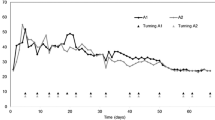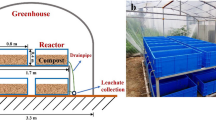Abstract
Green waste (GW) management is a key issue due to its high production rate and its variety of physical properties and chemical composition. Composting is a promising alternative for GW treatment and valorization. However, the presence of recalcitrant components such as lignin and cellulose increase the processing time. Strategies such as addition of co-substrates and operative modifications have improved the processing time and compost quality. Therefore, in this study, three strategies have been implemented (i) addition of unprocessed food (UF) and processed foods (PF) as co-substrates for GW to improve the nutrients composition of the substrates at the beginning of the process, (ii) addition of phosphate rock (PR) to improve product quality, and (iii) the use of two-stage composting (TSC) to accelerate the degradation. For this purpose, three treatments with the same mixture (48% GW + 21% UF + 18% PF + 13% sawdust (SW)) were conducted: (i) TA (TSC + 15% PR), (ii) TB (traditional composting +15% PR), and (iii) TC (traditional composting). TSC did not show significant differences compared with TC regarding the process and compost quality, while the addition of PR increased the phosphorus content of the product. However, TC produced the compost with the highest quality according to the Colombian legislation for soil amendment.



Similar content being viewed by others
References
Awasthi MK, Pandey AK, Khan J, Bundela PS, Wong JWC, Selvam A (2014) Evaluation of thermophilic fungal consortium for organic municipal solid waste composting. Bioresour Technol 168:214–221. https://doi.org/10.1016/j.biortech.2014.01.048
Barthod J, Rumpel C, Dignac M-F (2018) Composting with additives to improve organic amendments. A review Agron Sustain Dev 38:17–23. https://doi.org/10.1007/s13593-018-0491-9
Belyaeva ON, Haynes RJ (2009) Chemical, microbial and physical properties of manufactured soils produced by co-composting municipal green waste with coal fly ash. Bioresour Technol 100:5203–5209. https://doi.org/10.1016/j.biortech.2009.05.032
Belyaeva ON, Haynes RJ, Sturm EC (2012) Chemical, physical and microbial properties and microbial diversity in manufactured soils produced from co-composting green waste and biosolids. Waste Manag 32:2248–2257. https://doi.org/10.1016/j.wasman.2012.05.034
Benito M, Masaguer A, Moliner A, De Antonio R (2006) Chemical and physical properties of pruning waste compost and their seasonal variability. Bioresour Technol 97:2071–2076. https://doi.org/10.1016/j.biortech.2005.09.011
Bernal-Vicente A, Ros M, Pascual JA (2012) Inoculation of Trichoderma harzianum during maturation of vineyard waste compost to control muskmelon Fusarium Wilt. BioResources 7(2):1948-1960. https://doi.org/10.15376/biores.7.2.1948-1960
Boldrin A, Christensen TH (2010) Seasonal generation and composition of garden waste in Aarhus (Denmark). Waste Manag 30:551–557. https://doi.org/10.1016/j.wasman.2009.11.031
Brinton WF, Evans E, Droffner ML, Brinton RB (1995) A standardized Dewar test for evaluation of compost self-heating. BioCycle 36:1–16
Bustamante MA, Paredes C, Marhuenda-Egea FC, Pérez-Espinosa A, Bernal MP, Moral R (2008) Co-composting of distillery wastes with animal manures: carbon and nitrogen transformations in the evaluation of compost stability. Chemosphere 72:551–557
Bustamante MA, Ceglie FG, Aly A, Mihreteab HT, Ciaccia C, Tittarelli F (2016) Phosphorus availability from rock phosphate: combined effect of green waste composting and sulfur addition. J Environ Manag 182:557–563. https://doi.org/10.1016/j.jenvman.2016.08.016
Chiumenti A, Chiumenti R, Diaz L, Savage G, Eggerth L, Goldstein N (2005) Modern composting technologies. The JG Press. Inc., Singapore
Cooperband L (2002) The art and science of composting, a resource for farmers and compost producers. In: Center for Integrated Agricultural Systems. University of Wisconsin-Madison, Wisconsin, USA
Dulac N (2001) The organic waste flow in integrated sustainable waste management. —the concept. Waste. Tools for decision-makers: experiences from the urban waste expertise programme (1995–2001). Netherlands
Gabhane J, William SP, Bidyadhar R, Bhilawe P, Anand D, Vaidya AN, Wate SR (2012) Additives aided composting of green waste: effects on organic matter degradation, compost maturity, and quality of the finished compost. Bioresour Technol 114:382–388. https://doi.org/10.1016/j.biortech.2012.02.040
Huang GF, Wong JWC, Wu QT, Nagar BB (2004) Effect of C/N on composting of pig manure with sawdust. Waste Manag 24:805–813
Hubbe MA, Nazhad M, Sánchez C (2010) Composting as a way to convert cellulosic biomass and organic waste into high-value soil amendments: a review. BioResources 5:2808–2854
ICONTEC (1997) Norma Técnica Colombiana NTC 370. Abonos o fertilizantes. Determinación de nitrógeno total. Instituto Colombiano de Normas Técnicas y Certificación. Bogotá
ICONTEC (2001) Norma Técnica Colombiana NTC 234. Abonos o fertilizantes. Método de ensayo para la determinación cuantitativa de fósforo. Instituto Colombiano de Normas Técnicas y Certificación. Bogotá
ICONTEC (2004). Norma Técnica Colombiana NTC 5167. Productos para la industria agrícola. Productos orgánicos usados como abonos o fertilizantes y enmiendas de suelo. Instituto Colombiano de Normas Técnicas y Certificación. Bogotá
Imbeah M (1998) Composting piggery waste: a review. Bioresour Technol 63:197–203
INN – Instituto Nacional de Normalización (2004). Norma chilena de compost 2880–2004 (NCh 2880), Compost – Clasificación y requisitos. Santiago de Chile
Jain MS, Daga M, Kalamdhad AS (2018) Composting physics: a science behind bio-degradation of lignocellulose aquatic waste amended with inoculum and bulking agent. Process Saf Environ Prot 116:424–432. https://doi.org/10.1016/j.psep.2018.03.017
Koivula N, Urpilainen S, Ranta J, Kari H, Tarja R (2004) Ash in composting of source-separated catering waste. Bioresour Technol 93:291–299
Kreith F, Tchobanoglous G (2002) Handbook of solid waste management. McGraw-Hill, New York
López M, Soliva M, Martínez-Farré FX, Bonmatí A, Huerta-Pujol O (2010) An assessment of the characteristics of yard trimmings and recirculated yard trimmings used in biowaste composting. Bioresour Technol 101:1399–1405. https://doi.org/10.1016/j.biortech.2009.09.031
Malakahmad A, Idrus NB, Abualqumboz MS, Yavari S, Kutty SRM (2017) In-vessel co-composting of yard waste and food waste: an approach for sustainable waste management in Cameron Highlands, Malaysia. Int J Recycl Org Waste Agric 6:149–157
Mhindu R, Wuta M, Ngorima E (2013) Composting of selected organic wastes from peri-urban areas of Harare, Zimbabwe. Int J Recycl Org Waste Agric 2:14
Odlare M, Arthurson V, Pell M, Svensson K, Nehrenheim E, Abubaker J (2011) Land application of organic waste - effects on the soil ecosystem. Appl Energy 88:2210–2218. https://doi.org/10.1016/j.apenergy.2010.12.043
Onwosi CO, Igbokwe VC, Odimba JN et al (2017) Composting technology in waste stabilization: on the methods, challenges and future prospects. J Environ Manag 190:140–157. https://doi.org/10.1016/j.jenvman.2016.12.051
Oviedo-Ocaña ER, Marmolejo LF, Torres-Lozada P, Daza M, Andrade M, Torres-López WA, Abonia-Gonzalez R (2015a) Effect of adding bulking materials over the composting process of municipal solid biowastes. Chil J Agric Res 75:472–480
Oviedo-Ocaña ER, Torres P, Marmolejo LF, Hoyos LV, Gonzales S, Barrena R, Komilis D, Sanchez A (2015b) Stability and maturity of biowaste composts derived by small municipalities, correlation among physical, chemical and biological indices. Waste Manag 44:63–71
Oviedo-Ocaña ER, Dominguez I, Komilis D, Sánchez A (2019) Co-composting of green waste mixed with unprocessed and processed food waste: influence on the composting process and product quality. Waste Biomass Valorization 10:63–74
Paradelo R, Moldes AB, Barral MT (2013) Evolution of organic matter during the mesophilic composting of lignocellulosic winery wastes. J Environ Manag 116:18–26. https://doi.org/10.1016/j.jenvman.2012.12.001
Reyes-Torres M, Oviedo-Ocaña ER, Dominguez I, Komilis D, Sánchez A (2018) A systematic review on the composting of green waste: feedstock quality and optimization strategies. Waste Manag 77:486–499. https://doi.org/10.1016/j.wasman.2018.04.037
Rizzo PF, Torre V, Riera NI, Crespo D, Barrena R, Sánchez A (2013) Co-composting of poultry manure with other agricultural wastes: process performance and compost horticultural use. J Mater Cycles Waste Manag:1–9
Rynk R, van de Kamp M, Willson GB, Singley ME, Richard TL, Kolega JJ, Gouin FR, Laliberty L, Kay D, Murphy DW, Hoitink HAJ, Brinton WF (1992) On-farm composting handbook. Ithaca, NY, USA
Sánchez O, Ospina D, Montoya S (2017) Compost supplementation with nutrients and microorganisms in composting process. Waste Manag 69:136–153
SECOFI. 1985a. NMX-AA-015-1985 Protección al ambiente - contaminación del suelo - residuos sólidos municipales - muestreo - método de cuarteo. México
SECOFI. 1985b. NMX-AA-019-1985 Protección al ambiente-contaminación del suelo-residuos sólidos municipales-peso volumétrico ¨in situ¨. México
Troschinetz AM, Mihelcic JR (2009) Sustainable recycling of municipal solid waste in developing countries. Waste Manag 29:915–923. https://doi.org/10.1016/j.wasman.2008.04.016
USEPA (2015) Advancing sustainable materials management: 2013 fact sheet - assessing trends in material generation, recycling and disposal in the United States
Vandecasteele B, Willekens K, Steel H, D’Hose T, Van Waes C, Bert W (2017) Feedstock mixture composition as key factor for C/P ratio and phosphorus availability in composts: role of biodegradation potential, biochar amendment and calcium content. Waste Biomass Valorization 8:2553–2567
Varnero MMT, Rojas AC, Orellana RR (2007) Phytotoxicity indices of organic residues during composting. Rev Ciencia Suelo Nutr Vegetal 7:28–37 (in spanish)
Wei Y, Li J, Shi D, Liu G, Zhao Y, Shimaoka T (2017) Environmental challenges impeding the composting of biodegradable municipal solid waste: a critical review. Resour Conserv Recycl 122:51–65
Zhang L, Sun X, Tian Y, Gong X (2013) Effects of brown sugar and calcium superphosphate on the secondary fermentation of green waste. Bioresour Technol 131:68–75. https://doi.org/10.1016/j.biortech.2012.10.059
Zhang L, Sun X (2014a) Changes in physical, chemical, and microbiological properties during the two-stage co-composting of green waste with spent mushroom compost and biochar. Bioresour Technol 171:274–284. https://doi.org/10.1016/j.biortech.2014.08.079
Zhang L, Sun X (2014b) Effects of rhamnolipid and initial compost particle size on the two-stage composting of green waste. Bioresour Technol 163:112–122. https://doi.org/10.1016/j.biortech.2014.0
Zhang L, Sun X (2015) Effects of earthworm casts and zeolite on the two-stage composting of green waste. Waste Manag 39:119–129. https://doi.org/10.1016/j.wasman.2015.02.037
Zhang L, Sun X (2016a) Influence of bulking agents on physical, chemical, and microbiological properties during the two-stage composting of green waste. Waste Manag 48:115–126. https://doi.org/10.1016/j.wasman.2015.11.032
Zhang L, Sun X (2016b) Improving green waste composting by addition of sugarcane bagasse and exhausted grape marc. Bioresour Technol 218:335–343. https://doi.org/10.1016/j.biortech.2016.06.097
Zhang L, Sun X (2017) Addition of fish pond sediment and rock phosphate enhances the composting of green waste. Bioresour Technol 233:116–126. https://doi.org/10.1016/j.biortech.2017.02.073
Zhang L, Sun X (2018) Effects of bean dregs and crab shell powder additives on the composting of green waste. Bioresour Technol 260:283–293. https://doi.org/10.1016/j.biortech.2018.03.126
Zhang L, Sun X (2019) The use of coal fly ash and vinegar residue as additives in the two-stage composting of green waste. Environ Sci Pollut Res 26:28173–28187. https://doi.org/10.1007/s11356-019-05940-2
Funding
This work was carried out thanks to the support of the Universidad Industrial de Santander (Colombia), through the project 2354 of 2017.
Author information
Authors and Affiliations
Corresponding author
Additional information
Responsible Editor: Philippe Garrigues
Publisher’s note
Springer Nature remains neutral with regard to jurisdictional claims in published maps and institutional affiliations.
Rights and permissions
About this article
Cite this article
Hernández-Gómez, A., Calderón, A., Medina, C. et al. Implementation of strategies to optimize the co-composting of green waste and food waste in developing countries. A case study: Colombia. Environ Sci Pollut Res 28, 24321–24327 (2021). https://doi.org/10.1007/s11356-020-08103-w
Received:
Accepted:
Published:
Issue Date:
DOI: https://doi.org/10.1007/s11356-020-08103-w




